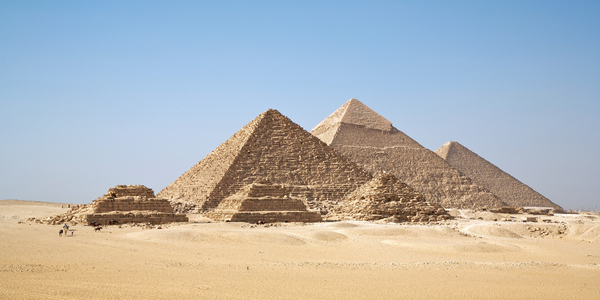Crazy Water Trick Helped Build The Pyramids

In elementary school, I was in the advanced learners class, which basically meant we got pulled out of class once a week to learn about stuff that was apparently too cool for the other kids. For my fifth grade year, we studied Egypt in depth and learned about everything from mummies to papyrus. One thing that has always intrigued me is how these ancient folks moved those gigantic blocks to build the pyramids. Scientists think they may finally have a better answer on how those gargantuan monuments were constructed, and all it took was a little bit of water.
According to Fox News, University of Amsterdam researchers think that Egyptians used wet sanded paths to move the blocks to build the pyramids. The makeshift roadway made it easier to pull their sleds, which were weighed down by 2.5 ton bricks. This meant they needed much less manpower to get materials from the quarry, where they were mined and shaped, to the building site. Its possible this process cut the necessary number of workers in half.
The water used to dampen the pathway created something called a liquid bridge. The process involves water molecules fusing together the sand like glue, keeping all the tiny grains in place. If you do it right, the wet sand is about two times more sturdy than it is dry. Too much wet sand created something that is very mud like. It probably took a lot of trial and error to get it right, but they obviously must have figured out the magic formula.
Think about running on dry sand and how much resistance you face with every step. Wet sand is much easier to run in, lessening the work on your legs. It only makes sense that this same phenomenon could have been observed by a smart Egyptian looking for ways to cut back on workers and time. It also kind of explains why more than one pyramid was built; if it didn't take as long as we once expected, the feat isn't quite as unbelievable. It's still absolutely fascinating how these people wanted to build their way up in the sky, even before skyscrapers were a thing.
It also seems like this research may have been staring us in the face for thousands of years. Some wall paintings in Egypt depict men moving the giant blocks on a sled, and someone ahead of them pouring some water. I'm not really sure what meaning researchers surmised before, but it seems pretty obvious to me that the water had something to do with the whole process. Whatever the case may be, I'm glad that more research is being done on ancient artifacts. Maybe it can give us some insight to the ancient world, and maybe help us make some improvements in the modern day. If not, at least it might improve Minecraft building.
CINEMABLEND NEWSLETTER
Your Daily Blend of Entertainment News

Stranger Things' Joe Keery Opens Up About Wrapping The Final Season, And My Heart Is So Full

Why Justin Baldoni's Team Now Claims Blake Lively Plotted With The New York Times For Months Before Her Bombshell Complaint

I Always Wondered Why The Rookie Wrote Out Rachel Years Ago, And Amid Her Return, The Show’s EP Shares A Reason That Makes Sense
Most Popular







